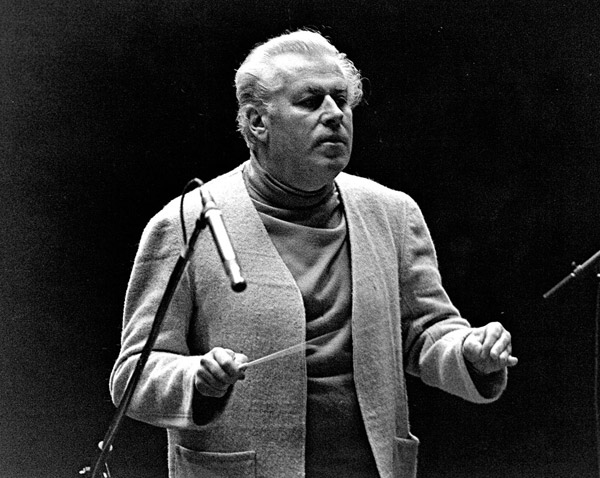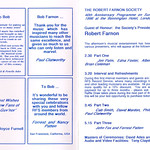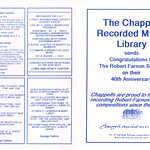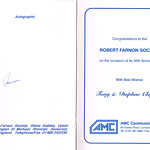The printed programme for the 40th Anniversary London Meeting and Banquet in 1996.
POLKA DOT
(Eric Cook)
Analysed by Robert Walton
Whenever serious light music is discussed, the conversation inevitably turns to the finest orchestra in the genre, the Queen’s Hall Light Orchestra. And it’s not just the standard of playing - that goes without saying. It’s also those unique compositions written by the top writers of the 1940s and 50s - Sidney Torch, Charles Williams, Clive Richardson, Wally Stott and of course Robert Farnon. In comparison with the premier production company Chappells, which made these marvels, much of the music of the minor mood labels was corny, predictable and frankly amateurish. Occasionally though, one comes across a piece which could have come straight out of that elite stable. Eric Cook’s Polka Dot is one such title that has all the elements of a QHLO standard about it, and well describes one of a number of round dots, repeated to form a regular pattern on fabric. Come to think of it, professional musicians often refer to musical notes as ‘dots’.
The slick string introduction might sound like a main melody but after 8 bars it soon becomes obvious the official tune, beautifully supported by a subliminal counter-melody, begins at bar 9 after some muted brass sets the scene. Then a very playful Farnon-like flute requiring absolute virtuosity gives the introduction a woodwindy boost followed by a lovely fill section. Then the strings imitate the flute. And just before the tune reappears we’re treated to another few bars of delicious close harmonies. It all sounds so totally 1940’s treasure trovish and the constant bustling motion almost takes your breath away.
Immediately after that busy opening, the orchestra goes into rest mode for a typically rich vocal-like sweeping middle section with strings, first in gorgeous close harmony then the bare tune. Even in 1957 the David Rose influence was present. And before we know it, we’re back to the beginning for a repeat. The tune of Polka Dot is gradually brought to a logical conclusion but near the end it’s suddenly interrupted by some more thrilling bravura playing from the flute before coming to a final stop.
Polka Dot is one of the most satisfying little light orchestral workouts I know, and British composer Eric Cook deserves high praise.
Polka Dot (Cook)
New Concert Orchestra/Cedric Dumont
“A Box of Light Musical Allsorts”
Guild Light Music (GLCD 5157)
E J MOERAN
In the Mountain Country Rhapsodies Overture for a Masque
Benjamin Frith, Piano; Ulster Orchestra ● JoAnn Falletta
Naxos 8.573106 (57:06)
E J Moeran … who he?
ROBERTO INGLEZ — ELGIN’S MARVEL
In the centenary year of his birth DON LEE suggests that it’s time to re-evaluate the pioneering output of Elgin’s Latin-American Scot.
Most people outside the readership of Journal Into Melody today have not heard of Roberto lnglez, nor listened to his very individual sort of Latin-American music. Yet, instantly recognisable — on his specialist slow numbers anyway — by his relaxed one-finger piano style that must have been the background music to many a romantic evening in the 1940s/1950s; this was easy listening mood music years before its time.
Lots of his recordings, issued on almost 100 Parlophone 78s have never made it to vinyl, let alone CD, although there are 3 CDs available on Vocalion (CDEA 6O62/6095/6131) and all are well worth acquiring. Guild CD have done their bit too and individual tracks by lnglez can be found on GLCD 5103/5133/5138/5173.
But who was lnglez and what were his origins?
Robert Maxstone Inglis was born June 29th 1913 at 7 West Road, Elgin in Morayshire. His mother was a 20 year-old ‘clerkess’ Jeannie Inglis; no father is listed in the birth register.
‘Berties’ piano lessons began at 5 years of age and by the age of 12 he had proved himself in exams. At 16 years, he was the pianist in a local band: Eddie’s Melody Makers. In 1933 a new roadhouse, ‘The Oakwood’, had opened on the outskirts of Elgin, where the brand new ’Bert Inglis Melody Makers’ provided the necessary music. The following year this ambitious little outfit won first prize in the preliminary heat for the North East of Scotland Dance Band Championship. They played three numbers: "Lullaby Lady", "You Or No One" and "A Bugle Call Rang Out". The main prizes were a cup presented by ‘The Tune Times’ and a year’s supply of dance orchestrations from Lawrence Wright Music. I wonder whatever happened to the cup?
Bert’s main occupation was training for dentistry but a choice had to be made: stay in Elgin with steady work or, inspired by his dedication to music and a determination to succeed, seek fame and fortune, perhaps, in London.
He left Elgin and enrolled at the Royal Academy of Music studying orchestration and arrangement and whilst there Bert met another enthusiastic student keen on the Latin sound then emanating from the London club scene — one Edmundo Ros. In 1940 Ros formed ‘Ros’s Rumba Romantics’ with Bert on piano — now renamed Roberto lnglez to fall in with the Latin image. Parlophone saw the commercial possibilities and despite wartime difficulties of shellac supply some 28 numbers were recorded in 1941/1942. Ros predominates but there is enough of the lnglez piano featured to judge how the Inglez style was developing.
By 1944, IngIez had left Ros to establish his own 9-piece rumba band. The new band played one most important date on October 15th 1944 at the now demolished Stoll Theatre on Kingsway: it was ‘Jazz Jamboree 1944’. HeadIining was the whole Glenn Miller AEF orchestra and strings, no less. Incidentally, the music programme recorded as also present the GeraIdo Orchestra with on 2nd Alto, one Wally Stott. It must have been quite an event.
In 1945, lnglez made a huge professional jump to become bandleader at London’s premier hotel, The Savoy, as relief band to Carroll Gibbons. Parlophone saw their chance again and lnglez, now with his own band, his own arrangements and — at last — his own sound, began to issue a long series of 78s beginning with "Laura" in October 1945. David Ades chose this for his EMI compilation ‘Memories Of The Light Programme’ in 1993. Even though the Light Programme didn’t officially open until 1946, "Laura" was regularly heard for many years after it was first released. Sometimes Roberto’s records were show tunes and film favourites amongst the instrumentals aimed at foreign markets, and there were a few inoffensive vocals by Inglez in an unmistakable Scottish burr.
However, prominent amongst the material recorded were slow and seductive Latin rhumbas like "Come Closer To Me", "Mi Vida" and "Frenesi", that if gathered together and sequenced would more than match any ‘Iate night/after hours’ material that predominated in LPs of the 60s and 70s, right up to the present.
By the late 40s Inglez was able to undertake foreign tours during the summer vacation and it was the success of these which eventually led to him to be summonsed back to The Savoy to fulfil his contractual obligations.
When EMI began to issue vinyl in 1953 there were three 45s and one 10" LP by the Roberto lnglez Orchestra but they were all 78 reissues. Another departure was in the field of Radio Programme/Library music and there is, at least one example of a live performance of the Inglez band for The Savoy in a half hour programme ‘London Town’. An advert reproduced in JIM No. 145 (December 2000) is the only evidence I’ve seen of this and more details would be very much appreciated if anybody can throw further light on this little-known aspect of lnglez’s activities.
In early 1954, with little warning, Inglez left The Savoy and emigrated to Chile to begin a new life there and the regular series of Parlophone 78s dried up. Recording activity in Chile remains scantily documented and awaits further research. However, a World Record LP of the early 70s ‘escaped’ to Britain and there were a handful of other albums released locally in South America.
There I must finish for the time being — hopefully there may be a revival of interest in this centenary year of the ‘Elgin Marvel’ that will lead to a re-evaluation of his unique style of music, and perhaps a more comprehensive reissue programme of his works.
Roberto Inglez died in Santiago on 4 September 1977 aged 65.
This tribute appeared in the August 2013 issue of ‘Journal Into Melody’
Robert Farnon's 100th birthday and updated 2005 JAZZ.FM tribute programme
Written by Pip WedgeWe are grateful to Pip Wedge (former RFS Canadian Rep and Journal Into Melody columnist) for the following information:
Robert Farnon lovers might like to know that Glen Woodcock, who has been broadcasting big band programmes on JAZZ.FM in Toronto for forty years, is updating a tribute programme he did in 2005 when Robert Farnon died, for broadcast this Sunday (23rd July) to mark what would have been Bob's 100th birthday on Monday (24th).
The programme can be heard via the Internet on Sunday evening at www.jazz.fm, 5:00pm – 10:00 pm Toronto time. Unfortunately that puts it from 10:00 pm to 03:00 am UK time, but maybe some people would like to stay up to hear an hour or so, while others might be able to record it. Sorry we couldn't let you know sooner, but Glen only just sent an email to give a heads-up.
CENTENARY CELEBRATION
Robert Farnon’s 100th birthday
By Robert Walton
July 24th 2017 is exactly 100 years since Toronto-born Robert Farnon first saw the light of day.

CENTENARY CELEBRATION
Robert Farnon’s 100th birthday
By Robert Walton
July 24th 2017 is exactly 100 years since Toronto-born Robert Farnon first saw the light of day. Much of my knowledge and praise of him has trickled down through my JIM articles especially in the miniatures. It’s amazing what one learnt from the music. Bob used to regularly ring me with a comment or two about my latest article. He appreciated my musical analyses and sometimes gave me details of the back-stories of his Canadian impressions.
Why does music move us? It’s a very personal thing really. There are many reasons we are affected, mostly impossible to fathom, but in Farnon’s case it’s a totally spiritual experience covering all the emotions especially in his magnificent miniatures. The great JS Bach affected us in much the same way. Farnon’s might be brief but they contain such a huge range of melodic and harmonic originality that they come up fresh every time. Each aspect of the music sends out an unspoken message of positiveness and hope. Normal language ceases to exist as the music does the talking.
Take Melody Fair for example. This radiant classically orientated two and a half minute masterpiece demonstrates Farnon’s natural sense of musicianship in which every element slots perfectly into place. Like a river it flows beautifully from start to finish. There never was or indeed ever will be such perfectly formed pieces of creativity. Strangely you get more for your money with a miniature.
In Farnon’s obituary I omitted to mention his arrangements of popular songs from shows and films. It was the first time many overseas fans ever heard his work. However they were generously sprinkled with the seeds of his miniatures.
It’s hard to believe 100 years have passed since he came into the world but his music from symphonies and film soundtracks right down to those towering miniature masterpieces, continue to excite the old guard and thrill the up-and-coming generations,
Although Robert Farnon is generally regarded as the greatest arranger of his generation, he surely must also be a strong contender for the title “Greatest Miniaturist of the 2Oth century”. Just as Bach’s 48 Preludes and Fugues, each lasting only a few minutes, is an entire world of music in miniature, so too are Farnon’s light orchestral pieces. Unfortunately because of his association with background music and particularly signature tunes, he never received the serious recognition he deserved. Only when his music is completely divorced from its original purpose and treated independently on its own merits, will it be properly appreciated. It may take a little time, but make no mistake that will come.
As well as his memorable music, it is not generally known that many musicians and arrangers including myself have reason to be grateful for his generosity with help and advice.
Happy 100th Bob!
(Gilbert; Sullivan)
Robert Farnon & His Orchestra
Analysed by Robert Walton
There can’t be many arrangements that have such a variety of musical nuts and bolts - Canadian Caravan, “James Bond”, “Maytime in Mayfair”, Count Basie, Fred Astaire and Gilbert and Sullivan...







